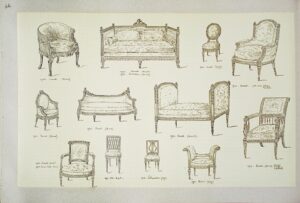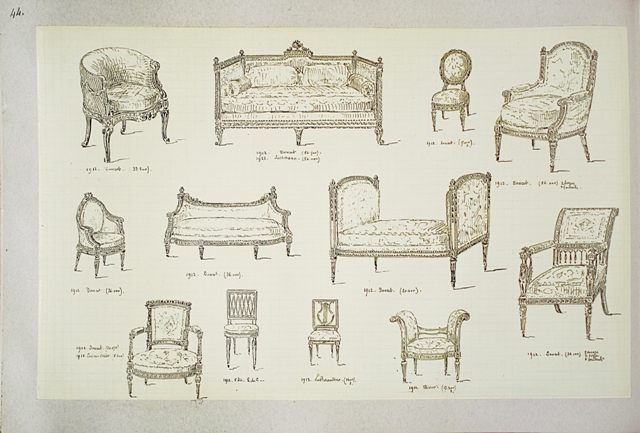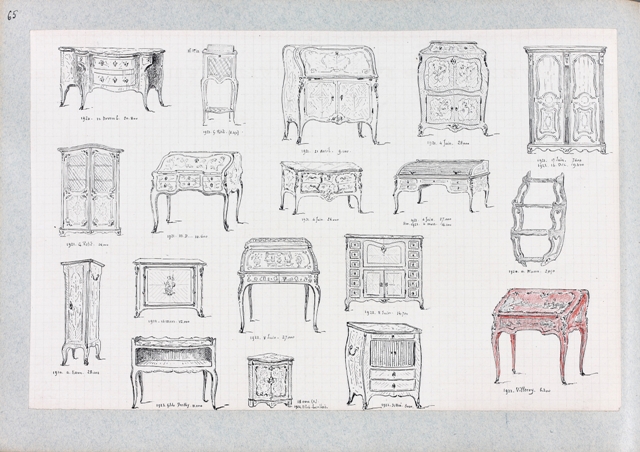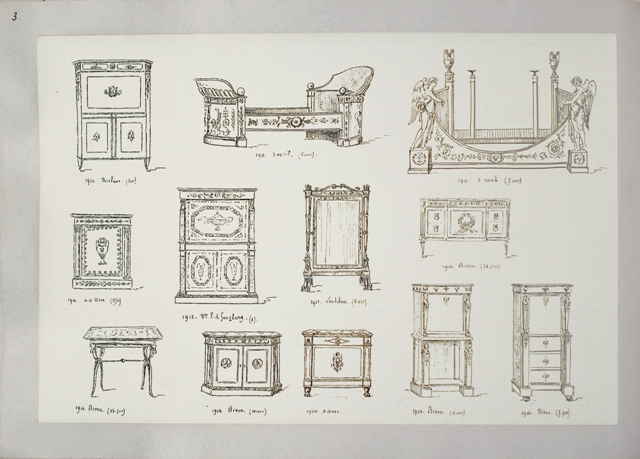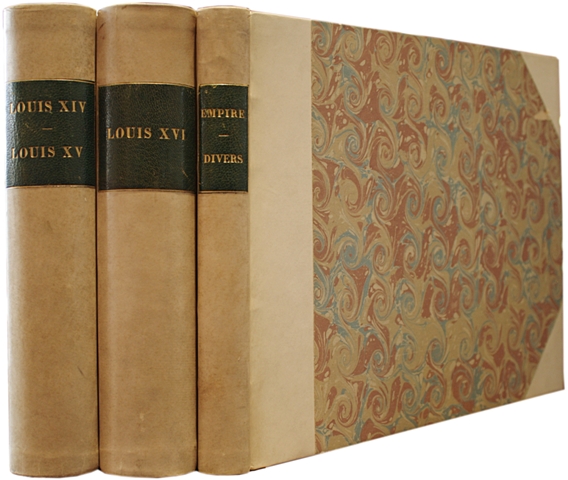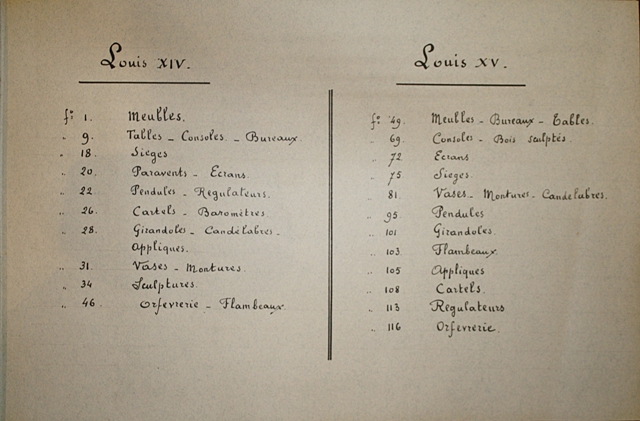PANNIER, H. Sketchbooks of furniture and decorative items. [Paris], between 1870 and 1924.
3 volumes oblong folio [395 x 267 mm] of: I/ (4) ll., 118 pp., (4) ll.; II/ (4) ll., 137 pp.; III/ (2) ll., 51 pp., (4) ll. The sketches of furniture are drawn from 4 to 23 per page, on blank pages that are stuck on the thicker leaves of the notebooks. Each drawn object has a caption. Bound in contemporary quarter vellum, flat spines, green morocco lettering pieces, slipcases. Contemporary bindings.
An exceptional testimony of the furniture and decorative items trade in Paris at the end of the 19th century and at the very beginning of the 20th century. A unique collection, complete with its 2800 original pen drawings representing the creations of the sumptuous Parisian furniture store, ‘l’Escalier de Cristal’.
The brothers Georges (1853-1944) and Henry (? – 1935) Pannier are since 1870 at the head of the sumptuous furniture store located at the corner of the streets Scribe and Auber, the famous Escalier de Cristal. They succeeded their father, Emile Augustin Pannier (1828-1892), in the business as well since he was the son of a crockery dealer.
The famous Parisian shop A l’escalier de cristal set up at the Palais Royal was created in 1804 by the widow Desarnaud, who was the first dealer to offer clocks, candelabras and ornamental vases associating cut crystal and gilt bronze. Her firm gets a great reputation because the objects she offers reach a high level of perfection. « L’Escalier de Cristal » quickly becomes an image of parisian luxury and elegance. Pierre-Isidore Lahoche acquires in his turn the store in 1847. Awarded many times at various exhibitions, l’Escalier de Cristal becomes a prestigious company that attracts worldwide rich lovers of furniture. Émile Augustin Pannier, who marries Célina Lahoche in 1852, becomes the owner of the company in 1866, enlarges the store by moving in the same building as the great hotel of the new opera. It is at this moment that appear at the Escalier de Cristal the first furniture, which are reproductions of antiques, compositions (pastiches freely interpreted of decorative arts from the 18th century) as well as a production of clocks and mantelpiece ornaments. The initiative comes from his sons, Henry and Georges, towards 1885, to create a very fashionable department expert on Japan. Until 1924 (the date of definitive closing of the store), the Pannier brothers will win many rewards and gold medals at national and international exhibitions and at the World Fairs.
« From 1900, the store doesn’t show in the categories reserved for ceramics, but in the one dedicated to art and furnishing bronzes, something the telltale of the World Fair rejoiced at: ‘Messrs. Pannier brothers, whose almost one hundred years old company is known under the name of ‛Escalier de cristal’ exhibit for the first time in our category, although they have an important place, one of the best ones, in the art furniture and bronze industry.’. The same one continues: ‘whether they are simple reproductions of antiques, or interpreted compositions of these same periods, their models are always especially well chosen, the taste distinguished, the execution perfect; a Louis XVI three-legged stool perfume burner, a bronze and marble column copied from the Louvre, a few fine porcelain frames, are exact reproductions; besides, we shall note two attractive display cabinets, one Louis XVI with figures of women, Clodion-style, the other Empire-style… and Louis XV and Louis XVI vase frames that are nothing but original compositions.’. The evidence is interesting: it shows that the Escalier de Cristal still has a solid reputation and especially that its furniture production in 1900 is acknowledged […]. Always concerned about the quality of the materials, and the refinement of execution, the Escalier de cristal directly stands in the tradition of the most luxurious productions of Parisian cabinetmaking […] The pieces of furniture of the Escalier de cristal surely count among the best successes of a genre originated from the quest of an imaginary Orient. A quest of which only a rich elite could get the wonderful results, a pedestal table costing from 1200 to 1800 francs, a table from 1000 to 1500 francs, shelves from 1200 to 1800 francs, a piece of furniture with two parts from 2800 to 6200 francs. Bankers, magistrates, lawyers, doctors and crowned heads represent the main customers of the Escalier de cristal. This clientele remains deeply attached and sensitive to the prestigious realizations from the 18th century, like the Pannier brothers themselves who owned a large collection of paintings and drawings from that period. » (P. Thiébaut, Contribution à une histoire du mobilier japonisant : les créations de ‘l’Escalier de Cristal’, dans la Revue de l’Art, 1989, n°1, pp. 76-83).
The Pannier brothers extend the store activity to the furniture trade from 1870 and it is Henry Pannier who looks after the artistic responsibilities within the fraternal association. He gets into the habit since 1870 of establishing a sketch of each piece of furniture or each item produced by the Escalier de Cristal and to record these drawings in notebooks. He is the author of the three sketchbooks of furniture that we present here.
Each of these three sketchbooks presents a period, a style of furniture offered for sale by the firm Pannier. The first sketchbook presents the set of Louis XIV and Louis XV-style productions, the second one are Louis XVI-furniture and the last one reproduces the objects of the Empire style.
Henry Pannier records here more than 2800 items offered by the firm Pannier between 1870 and 1924, closing date of the store. This inventory comprises many varied objects, such as tables and console tables, seats, screens, clocks, barometers, candelabras, wall lights and chandelier, plates, desks, beds, frames, firedog, inkwells …
Henry Pannier places next to each sketch the price of the object, the name of its executants and the identity of the customers. This is how we learn how many copies of each object were realized, to whom it was created, for which price and when it was sold. The names of the customers revealed in this books prove that only a rich elite could afford the sumptous productions of the Pannier brothers: bankers, magistrates, lawyers, doctors and crowned heads represent the main clientele of the Escalier de Cristal. The names that come the more often are the following ones: Hamilton, Sichel, Leroux, Duplessis, de Béthune, Rosenberg, Belozersky, Seillières, Stein, Franchetti, Choiseul, La Béraudière, Leroy, Doucet, Decourcelle, Cocteau, Baron Lepic, Montgermont, Biron, Talleyrand, Allard, Château de Merantais, Levy, Roussel, comte de La Ferrière, …
An exceptional and unique collection, entirely contemporary drawn by the great Parisian furniture dealer Henry Pannier. It is of the utmost interest not only for the history of French furniture and decorative arts from the end of the 19th century and the first quarter of the 20 century, but also for the information it provides about the contemporary rich European elite lifestyle.
Provenance: Henry Pannier with his ex libris on the first volume paste-down.
